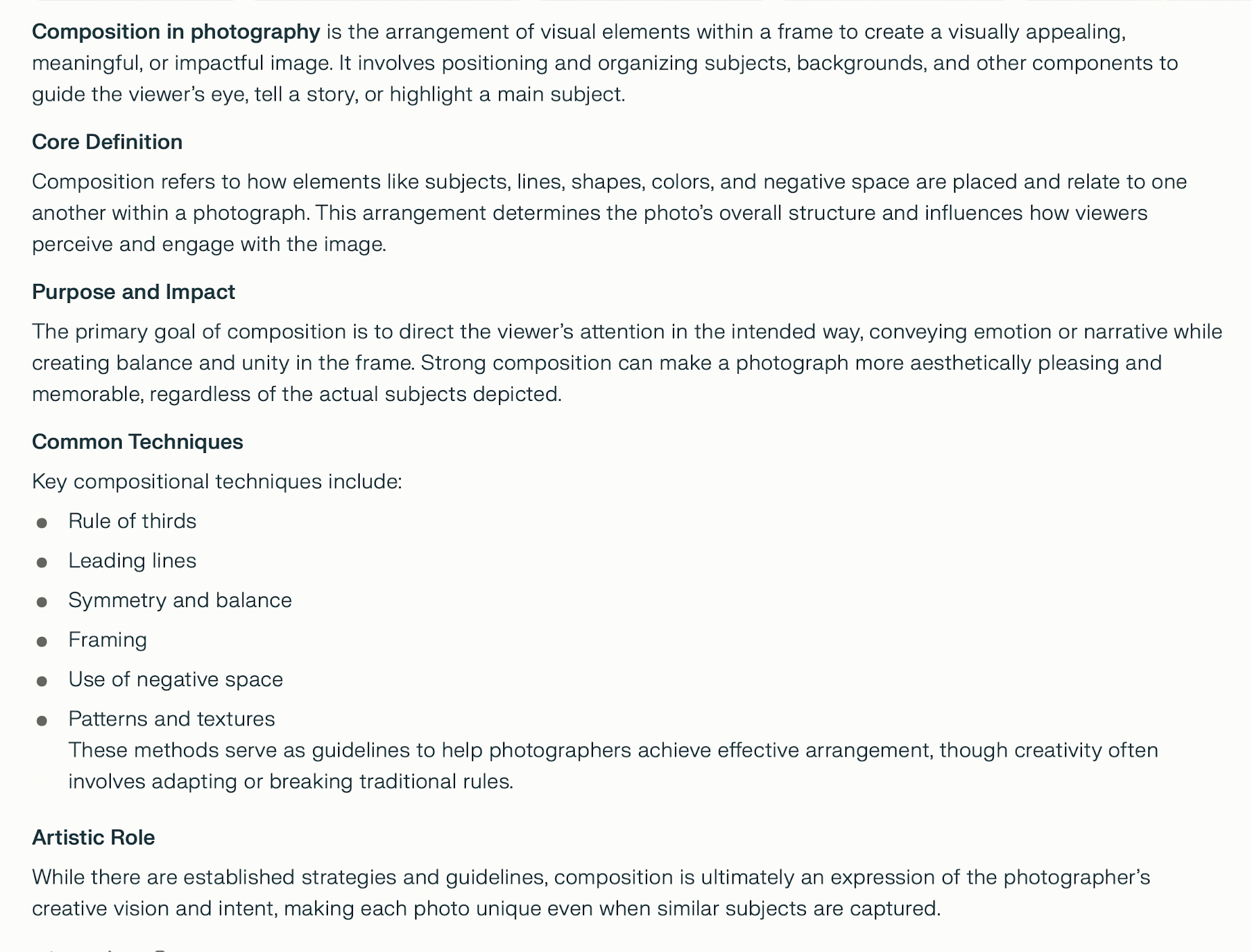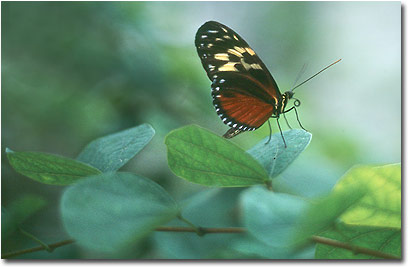COMPOSITION
 The Creative Photographer - Composition Tutorials
https://www.creative-photographer.com/all-tutorials/composition/
https://www.creative-photographer.com/rule-of-thirds-composition/
https://www.creative-photographer.com/beyond-the-rule-of-thirds/
https://www.creative-photographer.com/more-depth-photos/
The Creative Photographer - Composition Tutorials
https://www.creative-photographer.com/all-tutorials/composition/
https://www.creative-photographer.com/rule-of-thirds-composition/
https://www.creative-photographer.com/beyond-the-rule-of-thirds/
https://www.creative-photographer.com/more-depth-photos/
 This is an interesting photo to analyze because the subject's
face is positioned close to a third. The photographer was
actually concentrating on the compositional balance between
the subject, whose eyes are the focal point of the photo,
and the background, which is blurred because of the aperture
used (f2.8).
This is an interesting photo to analyze because the subject's
face is positioned close to a third. The photographer was
actually concentrating on the compositional balance between
the subject, whose eyes are the focal point of the photo,
and the background, which is blurred because of the aperture
used (f2.8).
 Emphasize your scene's depth by including interesting subjects
at varying distances from the camera. Image by Jule Berlin.
Composition: Examples and Exercises [Magnify: Command +]
http://www.ultimate-photo-tips.com/photograph-composition.html
Emphasize your scene's depth by including interesting subjects
at varying distances from the camera. Image by Jule Berlin.
Composition: Examples and Exercises [Magnify: Command +]
http://www.ultimate-photo-tips.com/photograph-composition.html

PHOTO ASSIGNMENT - Focus on the subject
Often the purpose of a portrait is to convey emotion or the
character of a person--something interesting or compelling.
Perhaps telling a story.
Photograph an adult human face. Be creative. Pay attention to
the background. The background can provide context, but the
face needs to dominate the image.
Candid photography is often preferred so you capture the
person as they really are. Furthermore, when the person is
looking into the camera there is an implied communication
with the viewer. When the person is looking elsewhere, it's
like you're looking in on a scene as an unobtrusive observer.
For dSLR photographers, using the largest aperture helps. For
iPhone photographers, get close (one meter). Portrait mode
may help.
VISUALIZATION
Our minds create images when we read a book, listen to
the radio, or just think. How might you go about making
photographs similar to the imagery in your mind?
Excerpt from ROBERT FROST - A TRIBUTE TO THE SOURCE
Frost was at work on a new book. Poems from Derry were still
maturing, some from England were almost ready. He had never
succeeded in larruping a poem as one might a horse to make it
go. Poems had to come to him in their own ways:
"A poem begins with a lump in the throat; a home-sickness or a
love-sickness. It is a reaching-out toward expression; an
effort to find fulfillment. A complete poem is where an
emotion has found its thought and the thought has found the
words".
Some poems took years to find their words. Among the
slow-growers was "Birches." The impulse for "Birches" had been
with him from the earliest memories in Lawrence, never
changing, always nagging him with the sensations of striving
and balance, but always incomplete. Throughout Derry the poem
seemed to be waiting a revelation. In England (where no boys
swing birches) Frost found the physical act carried through to
a spiritual meaning, something to do with Earth and human
aspirations. Now, in Franconia, after three full decades, the
poem found its thought and the thought worked out its words.
There were other times when words came bubbling like a spring
runoff. At such times Frost would often write straight through
the night. One spring night a few years later he found the
cantankerous drafts of a long satiric poem suddenly turned
agreeable, almost doing the writing for him. During five hours
he hurried to keep up--images, stories, history, snatches of
conversation, phrases flowing together as though following
some unseen channel. The poem ran on page after page without
serious hindrance right to the concluding ironies. Only then
did he look up. Dawn's first graying had begun outside his
window; across the road the angular rooflines of a barn were
emerging. He realized how tired he was, let out completely.
He got up to make coffee. Opening the door, he watched the
light coming and listened to the birds waking up in the
trees... Suddenly he knew he had company: in that tranquil
moment a new troupe of words began to play through his mind:
Whose woods these are I think I know....
Pine trees, dusk, December, a horse-drawn sleigh, falling
snow--where did these words come from, so unbidden, so
self-assured?
His house is in the village, though;
He will not see me stopping here
To watch his woods fill up with snow.
Derry again, never-to-be-forgotten Derry. The words drifted
down out of the dark memories: a Christmas Eve when, much too
late to be selling anything, he had driven into town to peddle
milk and eggs in order to buy presents--no one interested, all
busy with their own family celebrations--returning home
empty-handed. And yet this poem seemed bent on avoiding the
personal reality in order to create a new reality of its own.
To make matters more difficult the lyric demanded a tighter
than usual bonding of rhyme: four rhymes instead of two, and a
linking of one stanza to the next: a-a-b-a, b-b-c-b, c-c-d-c
...
This posed an enormous challenge: how to keep such a linkage
going. Dante could manage a rhyme-chain in Italian, but in
English the weight of crude links usually buried its poem.
Frost felt the bind at once. Four times he tried to get into
his second stanza; four times the lines collapsed. Going on to
explore the third stanza, he had better luck.
He gives his harness bells a shake
To ask if there is some mistake....
Beginning with the right words, the third stanza not only
moved freely to completion but showed the poet how to go back
and remake the second.
One other test remained: the ending; where and how to cut the
rhyme-chain. Leave it dangling? Stop the poem in a final three
rhymes? Jam the end with five rhymes? Try to hook the last
link back into the first stanza? All were unworthy of the
symmetry the poem has promised itself.
Frost tried one line, then another; both were wrong. But
half-hidden in the words of the second attempt--"that bid me
on, and there are miles"--he saw the shining ending he had
been looking for.
The collaboration was done, the unexpected company satisfied.
Groggy but elated, Frost could now go to bed. The Sun was just
coming up.
"Stopping by Woods on a Snowy Evening" is a work of pure
sorcery. Whatever there is about good poetry--a mystery beyond
meter, rhymes, images, metaphor--it throws a spell over the
simple scene. An experience of pain and humiliation is wholly
transformed. Poet, reader, light, dark, duty, life, love join
in an instant of communion. No words or rhythms interrupt the
spell. They all move in a planetary harmony. Form and energy
become one within the poem, as elemental as the mystery of an
atom. The poem is a culminating display of why Frost trusted
form.
STOPPING BY WOODS ON A SNOWY EVENING
Whose woods these are I think I know
His house is in the village, though;
He will not see me stopping here
To watch his woods fill up with snow.
My little horse must think it queer
To stop without a farmhouse near
Between the woods and frozen lake
The darkest evening of the year.
He gives his harness bells a shake
To ask if there is some mistake.
The only other sound's the sweep
of easy wind and downy flake.
The woods are lovely, dark and deep,
But I have promises to keep,
And miles to go before I sleep,
And miles to go before I sleep.
From:
ROBERT FROST - A TRIBUTE TO THE SOURCE
Poems by Robert Frost
Photographs by Dewitt Jones
Text by David Bradley
Holt, Rinehart and Winston, New York 1979
PS3511.R94Z518 1979 811'.0'12 [B] 78-10444
ISBN 0-03-046326-2
sam.wormley@icloud.com
The Creative Photographer - Composition Tutorials https://www.creative-photographer.com/all-tutorials/composition/ https://www.creative-photographer.com/rule-of-thirds-composition/ https://www.creative-photographer.com/beyond-the-rule-of-thirds/ https://www.creative-photographer.com/more-depth-photos/
This is an interesting photo to analyze because the subject's face is positioned close to a third. The photographer was actually concentrating on the compositional balance between the subject, whose eyes are the focal point of the photo, and the background, which is blurred because of the aperture used (f2.8).
Emphasize your scene's depth by including interesting subjects at varying distances from the camera. Image by Jule Berlin. Composition: Examples and Exercises [Magnify: Command +] http://www.ultimate-photo-tips.com/photograph-composition.html
